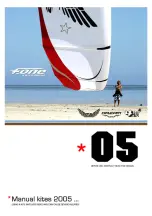
14
(&(
The Muse 3 is easy to reverse launch. When doing a reverse launch or when launching
in strong winds the paraglider can possibly surge forward more quickly or lift off sooner
than desired. To avoid this, walk uphill following the canopy during inflation. As this
launch technique can be difficult and turning the wrong way can result in the pilot taking
off with twisted risers. It is recommended to practice the reverse launch on a training hill
or slight slope first. When deflating the canopy in strong winds, or aborting a launch, use
the C- or D- risers, not the brakes. Using the brakes in strong wind will cause more lift,
lifting the pilot up and dragging him/her much further back.
If you let the brake handles go out of your hands during take-off, take care that the
brake line is not twisted around the brake pulley
Flight:
The glider is delivered with a standard set-up and its speed can reach 36 - 38 km/h
depending on the weight of the pilot. Always fly with sufficient clearance from the terrain.
The Muse 3 glides best with open brakes, descends best with lightly applied brakes. In
turbulence fly with brakes lightly applied (10-15 cm) to avoid canopy collapse. If the
canopy pendulums forward, this should be corrected by prompt braking. A pendulum
movement of the canopy backwards is corrected by loosening the brakes in good time.
In a calm air the Muse 3 can reach its minimum speed (depending on the wing loading)
by application of 60cm up to 65cm of the brake range.
Accelerated Flight:
When flying with the speed system applied the angle of attack is lower and the canopy
can collapse more easily than in normal (trim) flight. The faster the canopy is flown the
more dynamic the collapses and stalls will be and the more skill will be required for
quick recoveries. Therefore do not use speed system in turbulent conditions, close to
the ground or near other airspace users. Always fly with sufficient clearance from the
terrain and always keep the brake handles in your hands!
To use the speed system, simply place your feet on the stirrup and push forward in a
horizontal plane. If a loss of back pressure of the stirrup on your legs is noticed, this is a
warning that the canopy is probably about to collapse. Release the stirrup and thus the
speed system immediately. With this feeling you may actually prevent most collapses
from happening while using the speed system. If a collapse should still occur, release
the speed system immediately and correct the collapse as described below.
Attention: Do not apply brakes when fully accelerated! Braking increases lift near the
trailing edge. The main lift point moves backwards. Due to this the wing can loose
stability for a short time.
Steering - turns:
The Muse 3 is a very responsive paraglider and reacts very directly and instantly to any
steering input. Weight shift input quickens turns and ensures minimal height loss. Any
weight shift has a greater effect the more loosely the chest-strap is fastened. A
combined technique of weight shift and pulling on the inside brake line is the most
efficient turning method, whereby the radius of the turn is determined by the amount of
Summary of Contents for Muse 3
Page 1: ...1 ...
Page 23: ...23 LINE PLAN MUSE 3 ...
Page 26: ...26 CHECKS Name Company Date Signature Stamp ...
Page 28: ...28 ...














































